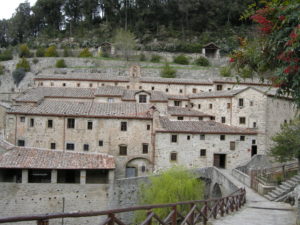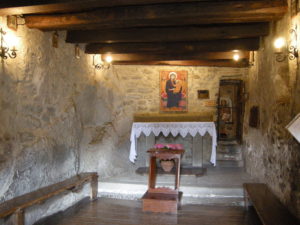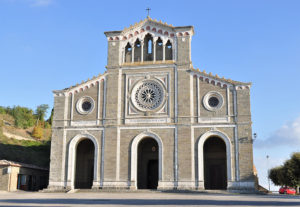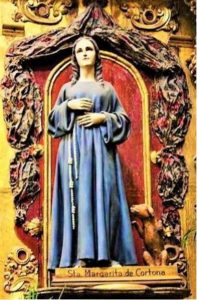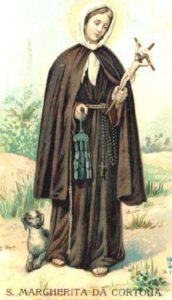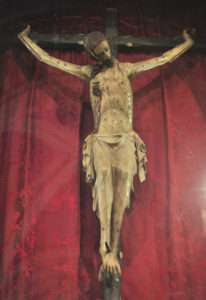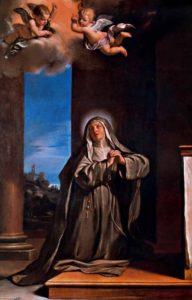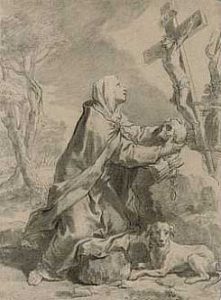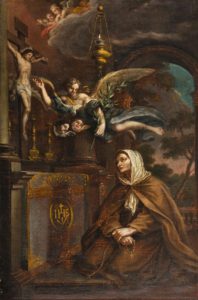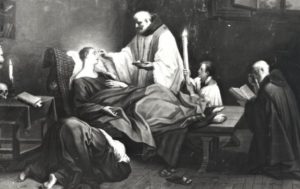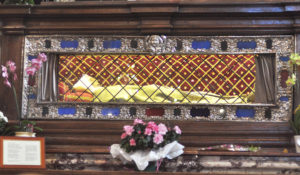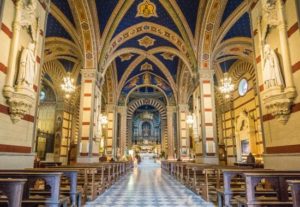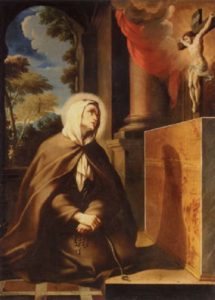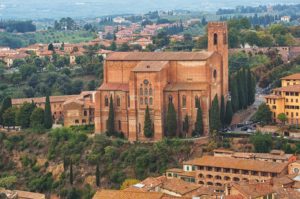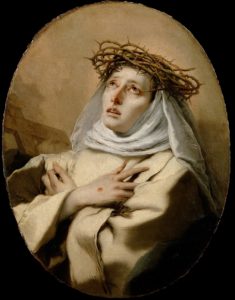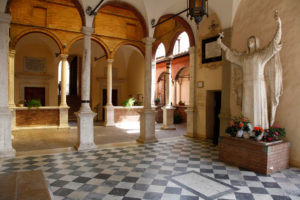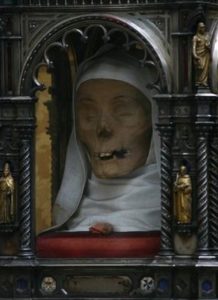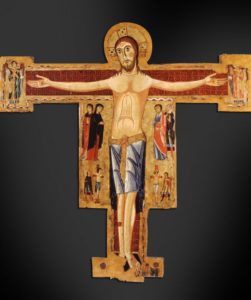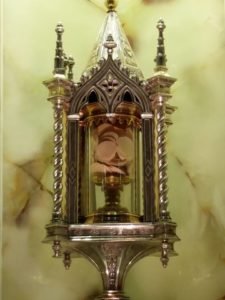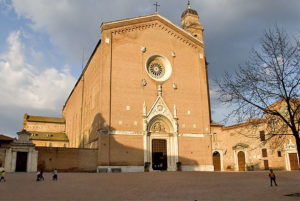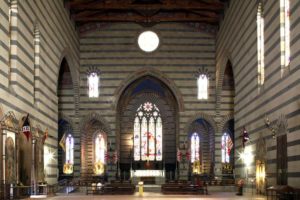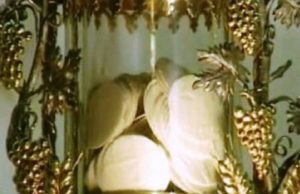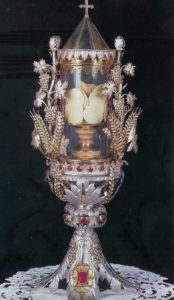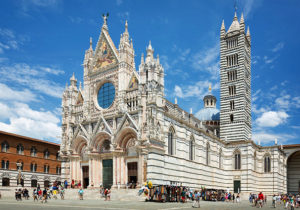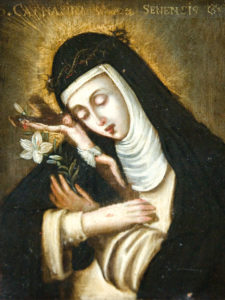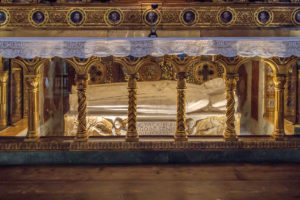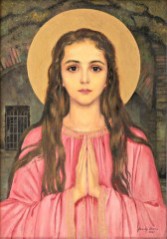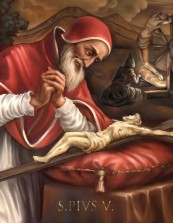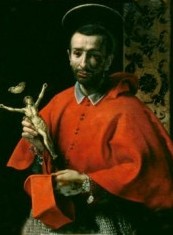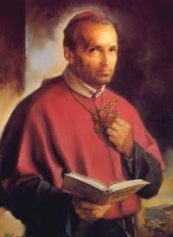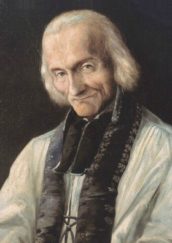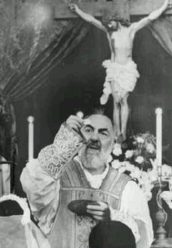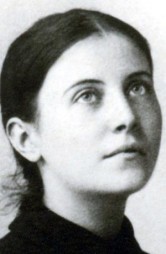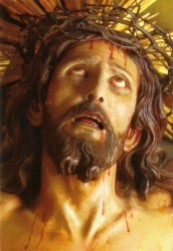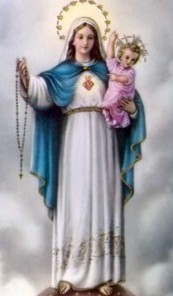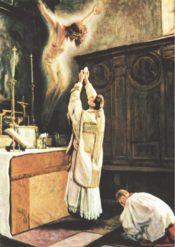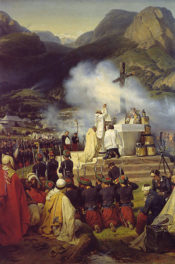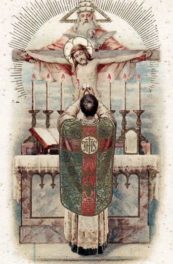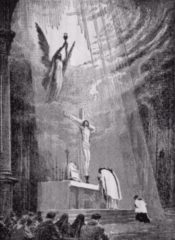Cortona: Saint Margaret of Cortona
Santuario di Santa Margherita (Piazza Santa Margherita 2, Cortona; daily from 6:50am to 7pm; https://santamargheritadacortona.com/santuario/)
Le Celle (13th cent. Franciscan hermitage approx. 4 km north of Cortona; daily from 7am to 7pm; Le Celle)
Cortona is a small hilltop town in Tuscany, about 50 km from Perugia and 110 km from Florence. There are frequent trains from Perugia to Camucia-Cortona and to Terontola-Cortona (the direct ones take about 40 minutes). The direct trains from Florence (Santa Maria Novella station) take about 1h 20 min to Camucia-Cortona (and 10 min longer to Terontola-Cortona) and are also frequent throughout the day.
The Camucia-Cortona train station lies about 3 km outside of the town of Cortona (if you don’t want to walk – it’s a steep climb uphill! – there are buses that stop outside the train station and take you to Cortona in 10 minutes). The Terontola-Cortona station is 10 km from Cortona (there are buses and taxis). You can also take a train from Rome (Termini or Tiburtina stations) to get to Cortona in approx. 2 hours.
A little over 4 km north of Cortona lies the hermitage Le Celle. It is the first convent built by St. Francis of Assisi (1211) who also lived there for several years. His cell can be seen there, as well as the small cave-like oratory used by his first companions. Since the 16th cent. the hermitage has belonged to the Capuchins. A 17th cent. church is part of the complex.
SAINT MARGARET OF CORTONA – THE SECOND MAGDALENE
Margaret was born in a village called Laviano, in the diocese of Chiusi, in the year 1247. Her mother was a good and pious woman who taught the child the basics of religion, prayers, and a love of God. Unfortunately her mother died when Margaret was only 7, and the woman her widowed father married two years later was cold and cruel towards her step daughter. To escape the unhappiness at home Margaret spent all the time she could in the company of other young people, enjoying in particular the attention and praise lavished on her by men bewitched by her great physical beauty.
When she was about 17 her path crossed with that of a nobleman from Montepulciano who, attracted by her beauty, promised to marry her if she went with him. Seeing it as a great opportunity to escape her circumstances, Margaret accompanied him to Montepulciano. There she lived for 9 years, in his palace, in opulence and luxury, having everything one’s heart might desire materially, as well as the care of countless servants and the admiration and adulation of the people.
Yet, once Margaret started listening to her conscience, her happiness evaporated. As she would later say, “in Montepulciano I have lost honor, dignity and peace, everything except the faith.” She never lost the faith, received from her good mother. And thus she was aware of the terrible sins she was committing, the scandal she was giving with her life to the simple people of faith, and the eternal destiny of her soul should she not repent and change. She tried to do penance by way of praying and giving alms with great generosity, but her will was too weak to cut the chains of carnal pleasures that bound her to her disordered life.
God, however, wanted to make her a great example of His boundless mercy with penitent sinners. Thus He cut off with a single painful cut the golden chains of the disordered passions.
Conversion from a life of sin
In 1273 her lover went off to take care of some business, accompanied by his faithful dog. The next day the dog returned without his master. The animal led Margaret to the nearby woods where she found the dead body of her lover, presumably murdered by bandits. Seeing his corpse, Margaret understood at once the nothingness of life and the importance of life everlasting. She trembled at the thought of her lover’s eternal destiny, and her own guilt in the sins his soul was judged for at the moment of his death. It was then that the faith of her childhood came back alive, and Margaret decided at once to henceforth live to expiate her great sins.
She returned to his relatives all the jewels and property her lover had given her and left his palace. With her 7 year old son, born of the illicit union, she set out for her father’s house. She was then 26. Her father, whom she implored forgiveness, would have let her stay in his home if it was not for the stern refusal of his wife. He didn’t have the strength to oppose his wife, and Margaret, desolated and destitute, had to leave.
The devil then launched the strongest temptations at the young woman, telling her she was young and beautiful and would find someone to love her and lavish the pleasures and luxuries of the world on her. But Margaret fought the temptations vigorously. She was determined to expiate her sins, and understood it was better to beg for her bread than to return to a life of sin. Her earthly father abandoned her but her heavenly Father would forgive her and receive her with love – of that she was certain. At the moment she made this resolution she heard an inner voice telling her: “Go to Cortona and place yourself under direction of the Friars Minor.” Margaret took her son and made the strenuous 20 km trek to Cortona.
(St. Francis of Assisi was preaching in Cortona around 1221 and, having attracted some followers, established with these new friars a hermitage near the town. This hermitage, called Le Celle, still exists and functions today. At the time Margaret came to Cortona the Friars Minor also had a convent in the town center.)
Margaret, upon entering Cortona, met two noblewomen who took pity on the poor mother and child and offered her and her son housing, promising also to take care of the boy’s education. Then they directed Margaret to a priest who, after listening to her story, sent her to Fr. Giunta Bevegnati of the Franciscan friars, a venerable priest known for his doctrine and holiness. After having confessed, with great remorse, all her sins to Fr. Giunta, she experienced for the first time in many years a profound peace. But Margaret wasn’t content with having her sins forgiven; she was determined to spend the rest of her life in penance and expiation for the great offenses against her Redeemer. (She took St. Mary Magdalene as a model, St. Francis of Assisi as a patron, and Fr. Giunta as a spiritual guide.)
From a great sinner to a great penitent
Margaret, once converted, didn’t waste any time. She cut her beautiful long hair, disguised her beauty, and renounced all sensual and pleasurable things. She lived on bread and water with some vegetables and fruit, wore a harsh cilice, and chastised her body with bloody disciplines, among many other penances and austerities. She saw her body – cause and accomplice of her crimes – as an irreconcilable adversary, and subjected it to more and more austerities and mortifications every day. Loathing her beauty which had led her and others into sin, she even wanted to cut her face but Fr. Giunta wouldn’t allow this, and she was always ready to sacrifice her wishes to the will of God manifested in the words of her spiritual director.
One Sunday she went to her native Laviano, where, in the church where everyone was assembled, dressed as a penitent with a rope around her neck, she begged on her knees the forgiveness of the people for her sins and the public scandal she had caused.
She spent her days in prayer and working, be it spinning wool, helping and assisting women who just gave birth, etc. The people of Cortona and later of all Tuscany marveled at seeing her heroic penances and virtues, and came to consider her a saint. Margaret’s big heart, once freed from the captivity of the false glow of worldly things and creatures, flew with all its strength toward God, the only One worthy of true love.
Margaret was from the beginning imploring the Friars to let her become a Franciscan tertiary. The Third Order of St. Francis had by then, less than 50 years after his death, spread to every part of Europe. The Friars let her wait for 3 years and, once certain that her change of life was lasting and that she would persevere, they clothed her in the habit of the Third Order in 1276. It was Margaret’s happiest day.
From then on she lived in a small room she called her little cell, stopped eating even the vegetables and fresh figs as if they were a luxury, slept on the hard floor, and spent a large part of the nights (often all night) in prayer and meditation of the Passion of Our Lord. She would only leave her cell to go to Mass early morning (at the conventual church of St. Francis) and, when needed, to attend the sick and poor to whom she gave her services freely.
Extraordinary graces and attacks by the enemy
Her first supernatural communication from Jesus happened while she was contemplating the crucifix at the church of St. Francis. She heard these words clearly coming from the Crucified: “What do you want, my poor sinner?” She replied without hesitation: “My Jesus, I do not seek nor want anything but You.” Another day, when she was praying, she asked God why He gives so many favors to such a miserable creature. And the same voice (of Jesus) that spoke to her on other occasions responded thus: “Because I have disposed that you become like a net for sinners. I want you to be a light for those sitting in the darkness of vice; I want the example of your conversion to preach hope to desperate sinners and be for the repentant ones like the morning dew for the plants exhausted by the heat of the sun; I want, lastly, that coming centuries be convinced that I am always willing to open the arms of my mercy to the prodigal son who, sincerely and with all his heart, returns to me.”
The following day Margaret experienced her first public ecstasy. While she was attending to a sick woman, she retired to a corner for a few moments to pray and, as the present witnesses testified, her face became illuminated, her eyes fixed to an invisible object in front of her, and her body rose from the ground and remained in the air while she was immersed in a loving communication with her Creator.
As Margaret began receiving these extraordinary graces from God, the devil also began assaulting her with force, appearing to her at times as an angel of light and at others as either himself or a horrid animal or even a fire-breathing dragon. At times he tempted her by making her remember the lavish and pleasurable time at Montepulciano in stark contrast with the privations of her current life, and by insinuating that the life of extreme penance she took upon herself was going to be too difficult to bear and persevere in.
Margaret never hesitated a moment before rejecting the temptations, only for the devil to return later tormenting her with blasphemies, impure images, or by telling her she was condemned to eternal fire. At other times he tried to tempt her to pride by telling her she was a saint, venerated and admired by everyone. In response to this Margaret, from the window of her cell, started loudly and publicly confessing her past sins by which she had so offended God and caused so much scandal to the people. At this the devil fled, not being able to suffer an act of such humility. Finally he tried to convince her that all the graces and favors she thought being of God were in fact his [the devil’s] work, that she was all his, and her life a lie and deceit. This left painful doubts in her mind but they were soon dispelled first by Fr. Bevegnati and then by Jesus Himself. These assaults of the devil lasted for the remainder of her life; the greater the graces God lavished on her, the stronger and more vicious was the hatred and persecution of Satan.
In 1286 Margaret founded, with the generous donations of noble families of Cortona, a home and hospital for the sick and elderly poor. Shortly thereafter she founded an institute of Franciscan Tertiary Sisters who would help her attend the sick and the poor. It was the first charitable institution of this kind in the Middle Ages.
Her only son became a Franciscan priest, as Jesus had foretold her some years before.
Spiritual nuptials, visions, mystic crucifixion
One of the extraordinary graces God gave to Margaret was that of the spiritual nuptials. Jesus took her, whom He at first only called “my poor sinner” and later “my daughter”, for His spouse. He also gave her the gift of discernment of souls, of prophecy, and of miracles. Her biographers, including Fr. Bevegnati, narrate many of these miracles. Perhaps the most famous of them was her bringing back to life a dead child of Cortona at the pleading of his desperate mother. The saint was also known to free people from demonic possession, and to miraculously cure the sick.
On the early morning of the Holy Friday, 1287, Margaret was in the church of St. Francis, having received the previous day a revelation from Jesus that she would experience a mystic crucifixion. After Mass she fell into an ecstasy during which she witnessed the entire course of the Passion and shared Jesus’ pain. This was witnessed, until 3pm when she seemed to expire along with the Redeemer, by many inhabitants of Cortona who were present at the church.
Margaret’s fame soon spread from Cortona and Tuscany to all parts of Italy and even to France and Spain. People from all these lands came to see her, ask her advice, beg her intercession, or seek consolation. She could read the souls of men, seeing both the hidden sins of the guilty ones and the fears and preoccupations of the just. Many sinners were converted and changed their life by seeing her holy example and hearing her exhortations. Included among them was an infamous chief of the Ghibellines, who, converted by Margaret, spent the rest of his life in austerity and penance in a Franciscan convent. She also exhorted the people of Cortona to make peace among themselves, and managed, for a time, to calm the strife between the various factions.
During Lent of 1288 Margaret was shown, in a vision, the horrible state of the sinful world, the unfaithful Christians, the evil of the Jews, the desecration of the Holy Land by the Mohammedans, and the offenses and outrages against Jesus. Seeing this, heartbroken, she offered herself to God as a victim of expiation. Her offer was accepted; a few days later, on March 25, she saw, after Communion, a luminous cross coming down from Heaven, on which she was to be crucified. Her Crucified Spouse appeared to her, telling her she would be crucified with Him, not in her flesh but in her heart. At that very moment a fiery arrow pierced her heart. The Redeemer also showed her a remote and miserable hermitage on a hill outside of Cortona where she was to retire and live in solitude.
Hermit
Margaret did not hesitate to fulfill God’s will, despite objections from everyone in Cortona. It was difficult for her to leave her poor and the hospital, as well as the Friars who had been directing her spiritually, and the church of St. Francis where she daily attended to religious services. But, she was Jesus’ victim, and so on May 1, 1288, she left Cortona to live in the hermitage shown to her in the vision. There she would spend the last 9 years of her life, living as a recluse.
Next to the hermitage was the ruined oratory of St. Basil which Margaret, with the material help of the town of Cortona, brought back to life. Once she began her hermit existence the divine favors and special gifts were withdrawn by God, and she was deprived not only of the presence of people but also of all supernatural consolations, feeling abandoned and rejected by God (Who was thus purifying her soul). This spiritual desolation lasted for more than a year, with the next 8 years being a mixture of loving contemplation and sufferings.
The people of Cortona, who before had admired and esteemed her, now turned against her, seeing her at best as useless and lacking constancy, and at worst as a charlatan and crazy. Margaret suffered it with patience and in peace, for the love of God, praying for her detractors and asking God that He may forgive them and let the hand of His justice fall on her instead. A cross harder for the saint to bear was the separation from her spiritual director Fr. Bevegnati who was, in 1290, transferred to Siena.
Margaret had a special devotion to St. Mary Magdalene, and animated sinners to do likewise. And, in these last 9 years of her life, she even imitated the Biblical penitent’s life as a recluse, spent in prayer, contemplation, adoration and love. In these years the penances and mortifications to which she subjected her body became even more severe, and she fasted almost permanently. With her incessant prayer and sacrifices she not only helped save countless souls but also averted God’s punishment from Cortona by expiating for the sins of her inhabitants.
Jesus, in several visions, promised Margaret that she would obtain everything she asked the Heavenly Father in His name. He also promised her “I will listen to and bless those who invoke you” – a promise not only given with respect to her contemporaries but even more so to future generations, including those of our own sinful times. Margaret, her dark night having passed, was frequently favored with visions of Our Lord, and on occasion of saints and angels. In many of these Jesus revealed to her the mysteries of His Sacred Heart, telling her that it was not yet time to make these known to the people [this task, to spread the devotion to the Heart of Jesus, would be given by Him to a Franciscan virgin of the 17th century]. Under obedience the saint was informing her Franciscan spiritual directors about the supernatural graces and divine conversations God had granted her.
Our Lord told her that she would die in Cortona and that He would grant the town a special privilege that would make it famous in all corners of the world (referring, most likely, to her incorrupt body).
Margaret also received from Jesus many prophecies regarding the Franciscan Order to which she was so closely linked. He told her that He would always give her a friar of the Order to direct her spiritually; He foretold the impending troubles to hit the Order and that they would serve to purify and strengthen it, and He called the Order His “garden of predilection”.
Jesus also told her in a vision: “If Francis was the first luminary of the Seraphic Order and Clare the second, you will be the third.” Thus Margaret is the model of penitent love, like the saint of Assisi is a model of apostolic life and St. Clare of virginity. St. Margaret is a model and helper of all sinners who should invoke her and ask her intercession that they may follow her path of repentance, penitence and burning love of God.
Source of Margaret’s strength and perseverance
Margaret had a great devotion to the Blessed Sacrament. Once she became a Franciscan tertiary Fr. Bevegnati authorized her to receive Holy Communion daily. In order to receive Jesus into as pure and loving a heart as possible, she was preparing for Communion from midnight with meditations. Before 6am she went to the church of St. Francis where she spent 2-3 hours in prayer and contemplation, preparing to receive Her Lord and King. After Communion she would remain for a long time, in a sort of ecstasy, contemplating, adoring and loving Him.
What was Margaret’s secret? The secret of the prodigious abnegation, sacrifice and charity that marked her life from the time of her conversion until her death was the Holy Communion. The Eucharist gave her the strength, constancy and light she needed to support her life of penance and sacrifice; it was the source of her fast progress in virtue and love. She told Fr. Bevegnati: “With the strength I receive from here [the Tabernacle] there is nothing that could detain me, and I see as nothing the most atrocious torments. What would I not do for the love of my Jesus?”
Margaret never tired of proclaiming to everyone the marvelous effects of Holy Communion, and the importance of receiving it worthily. She points to us the Tabernacle and invites us to go to Him Who is love and life Himself, in all our sufferings, difficulties and battles, to become strengthened by the source of all grace and virtue, the very heaven on earth.
Fr. Bevegnati came back to Cortona by the end of 1296. (Years earlier when he was sent to Siena God revealed to Margaret that he would come back and be present at her death.) Margaret was by then close to the end of her earthly life, plagued by rheumatism and neuralgia, and consumed by fever. On January 3, 1297, her guardian angel announced to her that she would, on February 22, change her exile for the triumphal joy of her heavenly homeland.
From February 5 to 22 she didn’t eat any food, living solely on the Eucharist which Fr. Bevegnati brought her daily in these last days of her life. Completely detached from all earthly things she now lived solely for Heaven. The whole town desired to see her in these last moments of her life, and she directed to each of them words of counsel and heavenly wisdom. To all she repeated “the way of salvation is easy: it’s enough to love.”
Death and miracles
On February 21 she received the extreme unction before passing the entire night in contemplation. The next morning she received the holy Viaticum and, as the angel had foretold, gave her soul to God. She was 50 years old. At the very moment she died a holy contemplative saw her soul in the form of a fiery globe flying to Heaven accompanied by a multitude of souls freed from Purgatory by her prayers and sacrifices.
The news of her death spread instantly and the inhabitants of Cortona rushed to see and venerate the body of their saint. And what a marvel – her face had, at death, recovered the freshness and angelical beauty of her youth, and from her body emanated a perfume similar to that of alabaster. All the present took these prodigies for a sign of Margaret’s eminent sanctity.
Acclaimed by the people as a saint, her body was translated to the church in a triumphal procession. After a solemn Mass the body was taken to the oratory of St. Basil (the one adjacent to her hermitage, which she had restored) and placed, inside an iron coffin, into a niche in the wall. There it remained, exposed for public veneration, even before her official canonization. The unanimous voice of the people called Margaret the new Mary Magdalene, title later ratified by Papal authority.
From the moment Margaret died her tomb became the scene of the most spectacular miracles. The dead brought back to life, the sick cured instantly, the maimed and paralyzed made whole, those in peril of life escaping miraculously, not to mention the countless spiritual favors. These were carefully recorded and examined by church authorities, as well as, among others, medical doctors. The miracles were so astonishing that in a short time Margaret’s tomb became the place of pilgrimage of all the sick, crippled and desperate. Rich and poor, young and old, noble and peasants… the records of all the instant cures of incurable and terminal illnesses would fill entire volumes.
Perhaps the most extraordinary miracles were those where dead were brought back to life by the intercession of the saint, such as a young man who, having been already laid in the coffin, was revived miraculously after his desperate mother begged God that he may, by the intercession of the holy penitent, repeat the miracle He did for the widow of Naim. The man thus brought back to life declared immediately that he owed his resurrection to the intercession of Margaret.
The saint has continued to intercede for those who have invoked her over the course of centuries. For instance, in 1745, a missionary who had worked in Peru declared and swore to the following miraculous appearance of Margaret to his fellow missionary priest who, devoted to the penitent of Cortona, was just praying a novena to her. One day before the novena was finished, Margaret appeared, radiant and dressed in her habit of the Third Order, to the priest and all the assembled Indians, promising to give a recompense for his zeal in promoting her glory. This left such an impression on the Indians that they too became devoted to her, invoking her in all their needs.
One could not omit mentioning the miraculous preservation of Margaret’s body, which, purified by penance and sacrifice, remains incorrupt to this day – more than seven centuries later. Not only that; her body has been, at times, known to exhale the most exquisite perfumes which have no equal among even the most aromatic substances of this earth.
Veneration and canonization of the “new Mary Magdalene”
Her remains have been honored with a public cultus from the very moment of her death. The oratory of St. Basil immediately became the center of pilgrimage not only for the people of Italy but other parts of Europe as well. The church soon became too small to accommodate the pilgrims, and Cortona decided to build a new sanctuary in her honor, to house her precious relics. Meanwhile the bishops of Arezzo and Chiusi started to catalog Margaret’s virtues and miracles for a process of canonization. They described her as “the miracle worker who gave back the sight to the blind, hearing to the deaf, and life to the dead.” Bishops from all parts of the Christian world recommended the faithful to make pilgrimage to Cortona, granting indulgences to those who visited the tomb of the holy penitent.
The Oratory of St. Basil came, in 1392, into the care of the Observant Franciscans. Thus came true the prophecy of Margaret that, as it had taken care of her soul, the Seraphic Order would later, after some time had passed, take care of her mortal remains.
In 1515 Pope Leo X came to visit Margaret’s tomb and, kneeling before the urn, felt the perfume her body was exhaling. He approved her cultus, authorized the celebration of her feast in the diocese of Cortona, and issued new indulgences to those who made the pilgrimage to her tomb. Cortona made her a patron of the city around the same time. In 1580 Margaret’s body was translated to the high altar where it rests until this day. In the 17th century it was placed in a crystal urn that allows people to contemplate her face.
Her sanctuary has been enlarged several times over the centuries. The current church owes its origins to a vote done by the inhabitants of Cortona in 1855 when Italy was being devastated by a cholera epidemic. Cortona lost, in a matter of a few months, a third of its population. The people went to Margaret’s tomb to implore her intercession and help, promising to build a new and larger sanctuary in her honor. Their prayers were heard and accepted, for from that day not a single more person fell victim to the epidemic. The people kept their promise and in 1877 the new sanctuary was opened. The flow of pilgrims received new life as people from all corners of Europe came to the tomb of the Magdalene of the Seraphic Order.
Light of repentant sinners
St. Margaret continues to correspond to the appeals of those who invoke her. Graces obtained by her intercession are particularly abundant when it comes to the cure of bodies and souls, as well as to women giving birth, and the conversion of sinners. Thus has been fulfilled the promise Jesus made to her: “I will bless in a special way all those who love and invoke you, and in many regions you will be the light of the sinners.”
St. Margaret, like Mary Magdalene, has loved so much that her sins were not only forgiven her but her ardent and selfless love and her tears, penances and sacrifices have given her, along with dignity and honor, a second innocence, not more beautiful but more moving than the first, for it was born of the clear tears of contrition.
On May 16, 1728 Margaret was canonized by Benedict XIII. He called her a new Mary Magdalene.
Her feast day is February 22.
Sancta Margarita, ora pro nobis!
—
St. Margaret of Cortona:
Life and Revelations of St. Margaret of Cortona (Fr. Giunta Bevegnati) – pdf, text, epub, kindle format
A Tuscan Penitent: The Life and Legend of St. Margaret of Cortona (Fr. Cuthbert) – pdf, text, kindle format
St. Margaret of Cortona: The Magdalen of the Seraphic Order (Fr. L. de Cherance) – pdf, text, kindle format
The Life of St. Margaret of Cortona (A. F. Giovagnoli) – pdf, text, epub, kindle format
Margaret of Cortona (F. Mauriac) – pdf, text, epub, kindle format

